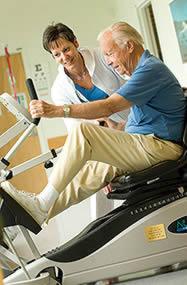To maintain your balance, your brain gathers and processes sensory information from your eyes, inner ear (vestibular system), and feet. Muscles and joints in your body then respond to what your brain tells them to do. Deficits in any of the sensory areas, including numbness in your feet, dizziness, visual problems, decreased strength, decreased flexibility, or neurologic diseases in the brain, can cause unsteadiness, which can cause you to fall.
Why falling is so dangerous and how we can help
- 30% of individuals age 65 and older will fall each year and 50% of those individuals will have more than one fall.
- 50% of individuals age 80 and over will fall each year.
- Those who fall may break bones and lose their level of independence; they may also become fearful of movement in general and decrease daily activities.
- Falls are the leading cause of nursing home admissions, the fifth leading cause of death overall in individuals 65 and older, and the leading cause of death from injury.
The good news is you can reduce your risk of falling. Falling is not a normal part of aging!
Studies have shown the most effective means for reducing your risk of falling is called Multifactorial Intervention. This approach can reduce your risk of falling by at least 30%. Using this method, we will teach you balance and strengthening exercises and give tips on how to make your home safer. We will also make sure you are evaluated by the right professionals to review the medications you take and address the medical conditions that can cause unsteadiness and dizziness.
Our physical therapists who specialize in balance rehabilitation will perform a comprehensive evaluation that includes tests for strength, flexibility, balance, gait (how you walk), and the vestibular system. We will recommend a program that addresses your specific areas of deficit to decrease your risk of falling. We will also help you develop a plan to maintain the gains you make after you finish your physical therapy program, either through home exercise programs or our weekly Wellness Program.
Quick tips to reduce your risk of falling
You can use these tips to help reduce your risk of falling, or you can download our Fall Prevention Guide (PDF).
Environment
Make your home and environment safer. Remove scatter rugs, loose cords, and clutter. Install railings on both sides of the stairs. Install grab bars in the bathroom. Make sure there is adequate lighting at night if you need to get up. Be sure to wear supportive, non-skid footwear. Take extra caution in the winter; consider using a trekking or ski pole and treads for your shoes. View and download the Home Safety Checklist (PDF).
Exercise
Working balance and strengthening exercises into your daily routine is essential. Remember, you can increase strength at any age. Ask for a referral from your primary care provider to our Balance Therapy Program to determine the best exercise approach for you.
Medications
Review your medications with your primary care provider. Make sure you take medications as prescribed and discuss any potential side effects you are having. Four or more medications can put you at risk for falling.
Regular check-ups
Schedule regular medical visits to receive optimal treatment for any health issues that could affect your balance, including diabetes, high blood pressure, cardiac diseases, or neurologic conditions.
Vision
Have your vision checked annually.
